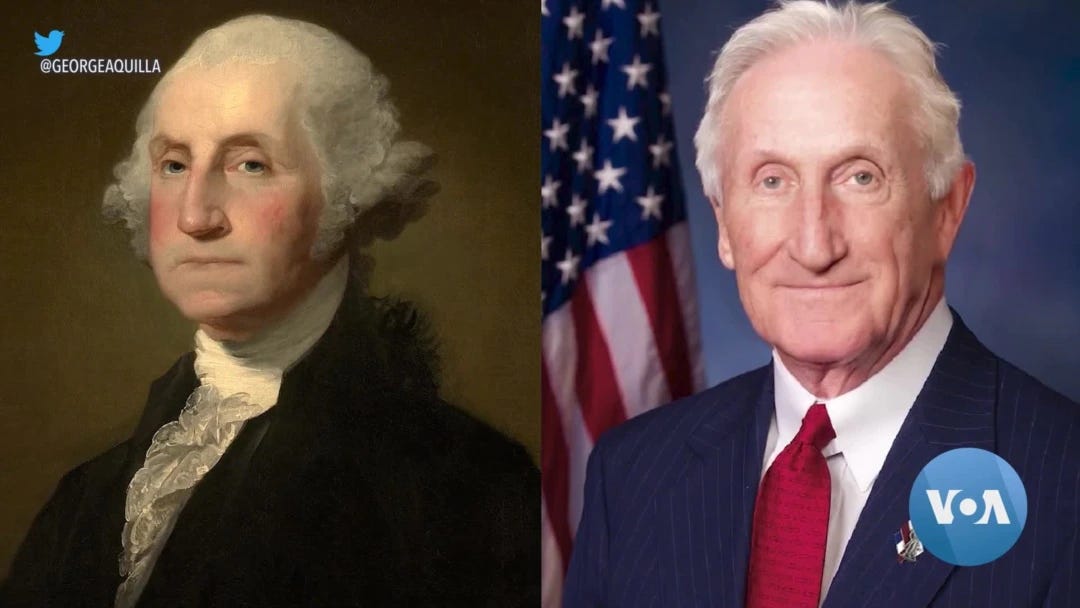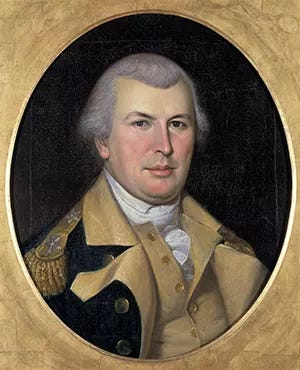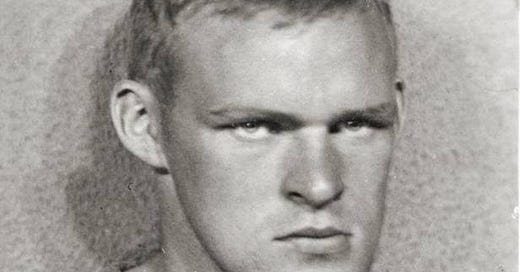Hello Friends,
Ordinarily, we focus on Border Security and current events. But it’s the 4th of July.
Thought it might be good to spend a few minutes on something we stumbled upon a couple days ago on Facebook of all places.
Do you know the story of Joseph Beyrle? When first reading about it in the wilds of some forward-chain on Facebook, one is tempted to think: “This can’t be real.”
Everything from the story, to the image above seems calculated to manipulate. It’s almost too good. The image of one angry looking American soldier in a prisoner-of-war camp photo looks more like a still from a Quentin Tarantino movie than anything else. “Piss3d Off Basterdz, American Boogaloo” or something.
But it’s as real as it gets:
Joseph Robert Beyrle (1923-2004) was a paratrooper with the 101st Airborne when he was caught by the Germans during the Normandy landings. Eventually, he managed to escape and wandered in the German countryside until he met Russian troops and persuaded their commanders to allow him to fight on the front line. He fought for a month and was wounded. Marshal Zhukov arranged for Beyrle's trip back to the US. Beyrle is the only American who fought the Germans in both the US and Red Armies during WW2.
Upon his enlistment, Beyrle chose to become a paratrooper, joining the 506th Parachute Infantry Regiment of the 101st Airborne's "Screaming Eagles" division, specializing in radio communications and demolition, and was first stationed in Ramsbury, England to prepare for the upcoming Allied invasion from the west. After nine months of training, Beyrle completed two missions in occupied France in April and May 1944, delivering gold to the French Resistance.
On June 6, D-Day, Beyrle's C-47 came under enemy fire over the Normandy coast, and he was forced to jump from the exceedingly low altitude of 120 meters. After landing in Saint-Côme-du-Mont, Sergeant Beyrle lost contact with his fellow paratroopers, but succeeded in blowing up a power station. He performed other sabotage missions before being captured by German soldiers a few days later.
Over the next seven months, Beyrle was held in seven different German prisons. He escaped twice, only to be recaptured each time. Beyrle and his fellow prisoners had been hoping to find the Red Army, which was a short distance away. After the second escape (in which he and his companions set out for Poland but boarded a train to Berlin by mistake), Beyrle was turned over to the Gestapo by a German civilian. Beaten and tortured, he was released to the German military after officials stepped in and determined that the Gestapo had no jurisdiction over prisoners of war. The Gestapo were about to shoot Beyrle and his comrades, claiming that he was an American spy who had parachuted into Berlin.
Beyrle was taken to the Stalag III-C POW camp in Alt Drewitz, from which he escaped in early January 1945. He headed east, hoping to meet up with the Soviet army. Encountering a Soviet tank brigade in the middle of January, he raised his hands, holding a pack of Lucky Strike cigarettes, and shouted in Russian, 'Amerikansky tovarishch! ("American comrade!"). Beyrle was eventually able to persuade the battalion's commander (Aleksandra Samusenko, allegedly the only female tank officer of that rank in the war) to allow him to fight alongside the unit on its way to Berlin, thus beginning his month-long stint in a Soviet tank battalion, where his demolitions expertise was appreciated
Beyrle's new battalion was the one that freed his former camp, Stalag III-C, at the end of January, but in the first week of February, he was wounded during an attack by German Stuka dive bombers. He was evacuated to a Soviet hospital in Landsberg an der Warthe (now Gorzów Wielkopolski in Poland), where he received a visit from Soviet Marshal Georgy Zhukov, who, intrigued by the only non-Soviet in the hospital, learned his story through an interpreter, and provided Beyrle with official papers in order to rejoin American forces.
Joining a Soviet military convoy, Beyrle arrived at the US embassy in Moscow in February 1945, only to learn that he had been reported by the US War Department as killed in action on June 10, 1944 on French soil. A funeral mass had been held in his honor in Muskegon, and his obituary was published in the local newspaper. Embassy officers in Moscow, unsure of his bona fides, placed him under Marine guard in the Metropol Hotel until his identity was established through his fingerprints.
Beyrle returned home to Michigan on April 21, 1945, and celebrated V-E Day two weeks later in Chicago. He was married to JoAnne Hollowell in 1946—coincidentally, in the same church and by the same priest who had held his funeral mass two years earlier. Beyrle worked for Brunswick Corporation for 28 years, retiring as a shipping supervisor.
His unique service earned him medals from U.S. President Bill Clinton and President Boris Yeltsin of Russia at a ceremony in the Rose Garden of the White House marking the 50th anniversary of D-Day in 1994.
Beyrle died in his sleep of heart failure on December 12, 2004 during a visit to Toccoa, Georgia, where he had trained with paratroopers in 1942. He was 81. He was buried with honors in Section 1 of Arlington National Cemetery in April, 2005.—Text from “AmericanHistory.net,” reproduced almost verbatim on Wikipedia
It’s interesting to note, the Soviet Army tank leader that Beyrle served with, Aleksandra Samusenko, did not survive the war. She was killed in 1945, about a month before Beyrle arrived back in the United States, during what was called the East Pomeranian Offensive. The fighting in Europe officially ended in May, just two months after her death.
Exactly how she died is not clear— some say she was run over by a Soviet driver, that was unaware he was crushing a group of people. Others say it was someone in a German self-propelled artillery piece that crushed her and the rest. Our inner nihilist suggests that the more terrible option— a sort of friendly fire— is the truth, and the other tale is one concocted by apparatchiks to make her death a little more politically palatable during a time of crisis like World War II.
Either way, a bad and sad piece of business.
It is interesting how on the 4th of July we all seem to gravitate to tales of military valor— making it something of another Memorial Day. Can’t help but think it has something to do with an unconscious need to focus on figures and times and moments that are unequivocally patriotic and worthy of veneration.
Veneration is all well and good. War and its horrors and unbelievable tales are well worth remembering for many reasons.
But let’s also take a minute to talk about the silly side of George Washington, because silliness is fun.

Many don’t know it, but George Washington wasn’t just the father of the Country— he was also the Lord of the Dance. It’s true— you can find references to the fact on the official website at Mt. Vernon.
Washington once described dancing as “so agreeable and innocent an amusement.” First-hand accounts say he was extremely good at it – and was always quite the center of attention.
—Text from mountvernon.org, the Website perhaps associated most closely with preserving George Washington’s history and legacy.
Partnered with Kitty Greene, the wife of General Nathanael Greene, George Washington danced in a marathon session on March 19, 1779. General Greene wrote from Middlebrook, New Jersey that, "His Excellency and Mrs. Greene danced upwards of three hours without once sitting down."
—Also from mountvernon.org
One can’t help but note the fact that General Greene was perhaps Washington’s most trusted subordinate— and by some accounts a better tactician by the end of the war. Greene led fighters in the Carolinas, brutally struggling against the British— fighting through what were a series of Pyrrhic victories by the Redcoats.

A pyrrhic victory is one where even though the result is technically a ‘win’ for one side, the cost of it is almost worse than a loss. The word Pyrrhic is taken from antiquity and King Pyrrhus of Epirus— in Greece, who defeated the Romans at the cost of almost his entire army, saying: "If we are victorious in one more battle with the Romans, we shall be utterly ruined.”

General Greene’s efforts in the Carolinas were so successful, many historians agree that he set the stage for Washington’s legendary victory at Yorktown.
By then, it was widely believed that Greene would become the leader of American revolutionary forces if Washington was ever lost in battle.
Washington was also, apparently, a heck of a card sharp.
In 1748, Washington noted in his account book that he had won 2s/3d (2 shillings and 3 pence) from his sister in law playing at whist— a revolutionary precursor to Bridge.
Later:

On a personal note— a very unlikely tale about George Washington is the foundation of one of our long favorite jokes about politics. It came to us more years ago than we like to remember, from former Texas Comptroller John Sharp, a Democrat, who was visiting Laredo during an annual event called the Fiesta de los Jueces, or “Judges’ Party.” Sharp is now the Chancellor at Texas A & M.
“A lot of folks don’t know it, but George Washington, the Father of our Country, was born and raised right near here, in Cotulla, Texas. It’s true. One day, George’s father came home to find George had chopped down his favorite Mesquite tree. Dismayed, he asked him, ‘Son, you chop down my favorite Mesquite?’ Young George squared his shoulders and said: “Yes Father, as I cannot tell a lie, I must tell you that yes, I did chop down your favorite Mesquite.” George’s father said to himself, ‘If this kid can’t tell a lie, then we better get back East. He won’t be worth a damn in Texas politics!”
Happy 4th of July, everyone.





Excellent storytelling. And very enjoyable. I like the Texas story about Washington.
This is excellent!